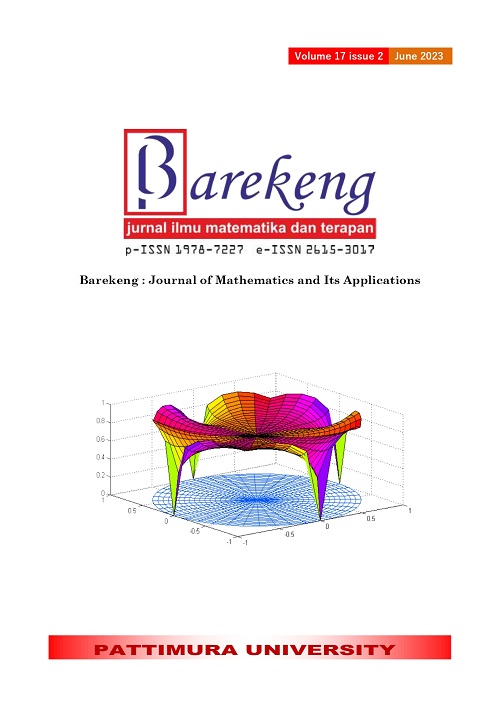GEOGRAPHICALLY WEIGHTED PANEL REGRESSION (GWPR) FOR COVID-19 CASE IN INDONESIA
Abstract
Coronavirus disease 2019 (COVID-19) is a newly emerging infectious disease caused by severe acute respiratory syndrome coronavirus-2 (SARS-CoV-2) which was declared a pandemic by the World Health Organization (WHO) on March 11th, 2020. The response to this ongoing pandemic requires extensive collaboration across the scientific community to contain its impact and limit further transmission. Modeling to see cause-and-effect relationships in an event usually uses the Multiple Linear Regression (Ordinary Least Square) method. But in the case of Covid-19, the spread of the virus occurred from one location to another, so there was an indication that there was a spatial effect on the incident. In this study, we did not only look at spatial perspective but also considered time series data, so the method used was Geographically Weighted Panel Regression (GWPR). This study modeled the number of positive cases of Covid-19 in 34 provinces in Indonesia that occurred from March 2020 to August 2021 and looked at what factors influenced the number of positive cases of Covid-19 in each province. GWPR was performed with the assumption of a Fixed Effect Model (FEM). The FEM assumption was used by considering that the conditions of each observation unit were different. Based on the results, the best GWPR model obtained was the GWPR model with a Fixed Gaussian Kernel. The predictor variables that influenced the number of positive cases of Covid-19 were different at each location and tent to cluster at certain locations.
Downloads
References
M. T. Meehan et al., “Modelling insights into the COVID-19 pandemic,” Paediatr. Respir. Rev., vol. 35, pp. 64–69, 2020.
K. Sarkar, S. Khajanchi, and J. J. Nieto, “Modeling and forecasting the COVID-19 pandemic in India,” Chaos, Solitons and Fractals, vol. 139, p. 110049, 2020.
V. Soukhovolsky, A. Kovalev, A. Pitt, and B. Kessel, “A new modelling of the COVID 19 pandemic,” Chaos, Solitons and Fractals, vol. 139, p. 110039, 2020.
S. Sifriyani and D. Rosadi, “Susceptible Infected Recovered (Sir) Model for Estimating Covid-19 Reproduction Number in East Kalimantan and Samarinda,” Media Stat., vol. 13, no. 2, pp. 170–181, 2020.
I. F. Mahdy, “Pemodelan Jumlah Kasus Covid-19 Di Jawa Barat Menggunakan Geographically Weighted Regression,” Semin. Nas. Off. Stat., vol. 2020, no. 1, pp. 138–145, 2021.
S. Sifriyani, M. Rasjid, D. Rosadi, S. Anwar, R. D. Wahyuni, and S. Jalaluddin, “Spatial-Temporal Epidemiology of COVID-19 Using a Geographically and Temporally Weighted Regression Model,” Symmetry (Basel)., vol. 14, no. 4, 2022.
N. Okthariza, “Kepadatan Penduduk dan Kasus Positif COVID-19 di Jakarta,” CSIS Comment., no. April, pp. 1–5, 2020.
E. Marhamah and I. G. N. Mindra Jaya, “Modeling positive covid-19 cases in bandung city by means geographically weighted regression,” Commun. Math. Biol. Neurosci., vol. 2020, pp. 1–10, 2020.
D. Yu, “Exploring spatiotemporally varying regressed relationships: The geographically weighted panel regression analysis,” Int. Arch. Photogramm. Remote Sens. Spat. Inf. Sci. - ISPRS Arch., vol. 38, pp. 134–139, 2010.
F. Bruna and D. Yu, “Geographically Weighted Panel Regression and Development Accounting for European Regions,” Int. Conf. Reg. Sci., pp. 1–20, 2016.
G. W, Econometric Analysis. New Jersey: Prentice-Hall Inc, 2000.
W. J. M., Econometric Analysis of Cross Section and Panel Data. London: MIT Press, 2002.
G. D. N. and P. D. C., Basic Econometrics. New York: McGraw-Hill/Irwin, 2009.
N. S. Rahayu, “Geographically Weighted Panel Regression For Modelling The Percentage of Poor People in Jawa Tengah Province,” Thesis, Institut Teknologi Sepuluh Nopember, Surabaya, 2017.
Z. Mar’ah, A. Djuraidah, and A. H. Wigena, “Semi-parametric Geographically Weighted Regression Modelling using Linear Model of Coregionalization,” Int. J. Sci. Basic Appl. Res., vol. 4531, no. July, pp. 178–186, 2017.
K. K. Ministry of Health, “Peta Sebaran dan Kasus COVID-19 di Indonesia,” 2021. https://in-422feksiemerging.kemkes.go.id/dashboard/covid-19/ (accessed Aug. 10, 2021).
Copyright (c) 2023 Zakiyah Mar'ah, Sifriyani Sifriyani

This work is licensed under a Creative Commons Attribution-ShareAlike 4.0 International License.
Authors who publish with this Journal agree to the following terms:
- Author retain copyright and grant the journal right of first publication with the work simultaneously licensed under a creative commons attribution license that allow others to share the work within an acknowledgement of the work’s authorship and initial publication of this journal.
- Authors are able to enter into separate, additional contractual arrangement for the non-exclusive distribution of the journal’s published version of the work (e.g. acknowledgement of its initial publication in this journal).
- Authors are permitted and encouraged to post their work online (e.g. in institutional repositories or on their websites) prior to and during the submission process, as it can lead to productive exchanges, as well as earlier and greater citation of published works.






1.gif)



